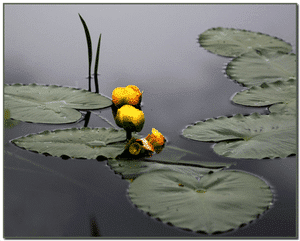Scientific name: Nuphar polysepalum
Native American names: west wind
Plant family: Nymphaceae
Description: Nuphar polysepalum grows from 15 to 60 cm and can spread up to one meter on the water surface. Instead of true roots, rhizomes buried in muddy pond bottoms anchor N. polysepalum. A thick stem rises directly from the rhizome to the flower, which is bright yellow with large sepals concealing smaller petals. The stigma is prominent and resembles a doorknob. The heart-shaped leaves, which are on a separate stem from the flower, range from 10-45cm and usually float on the surface of the water but can sometimes be submerged or emergent. N. polysepalum propagates both by seeds and rhizomes; seeds are dispersed on the water surface, and rhizomes reproduce vegetatively.
Habitat and range: Nuphar polysepalum can be found throughout North America, particularly from Alaska to California and in the Rocky Mountains, and it thrives in shallow lakes or ponds (generally 3-9 feet deep) as well as calm, slow moving streams.
Traditional and contemporary uses: Nuphar polysepalum is primarily harvested for culinary and medicinal uses; while the seeds are eaten, the rhizome is used for medicine and healing. The rhizomes are typically harvested in the spring, and can be boiled, dried, soaked and mashed, or steamed. The Thompson Indians, for example, dried and ground the leaves, and then mixed the powder with grease and used the ointment for bites, swellings, and infections.[1] The Haida use the rhizome for treating “colds, tuberculosis, internal pains, ulcers, rheumatism, chest pains, heart conditions, and cancer”.[2]
The seeds, harvested in late summer or early fall, can be prepared several different ways including drying, grinding, frying, roasting, and soaking. The Klamath and Mendocino tribes make the seeds into porridge via grinding and roasting the seeds. The seeds are an important food source for the Klamath and other coastal indigenous groups of the California and Oregon coast.
Drawing on the following page by Casey Mangnall


